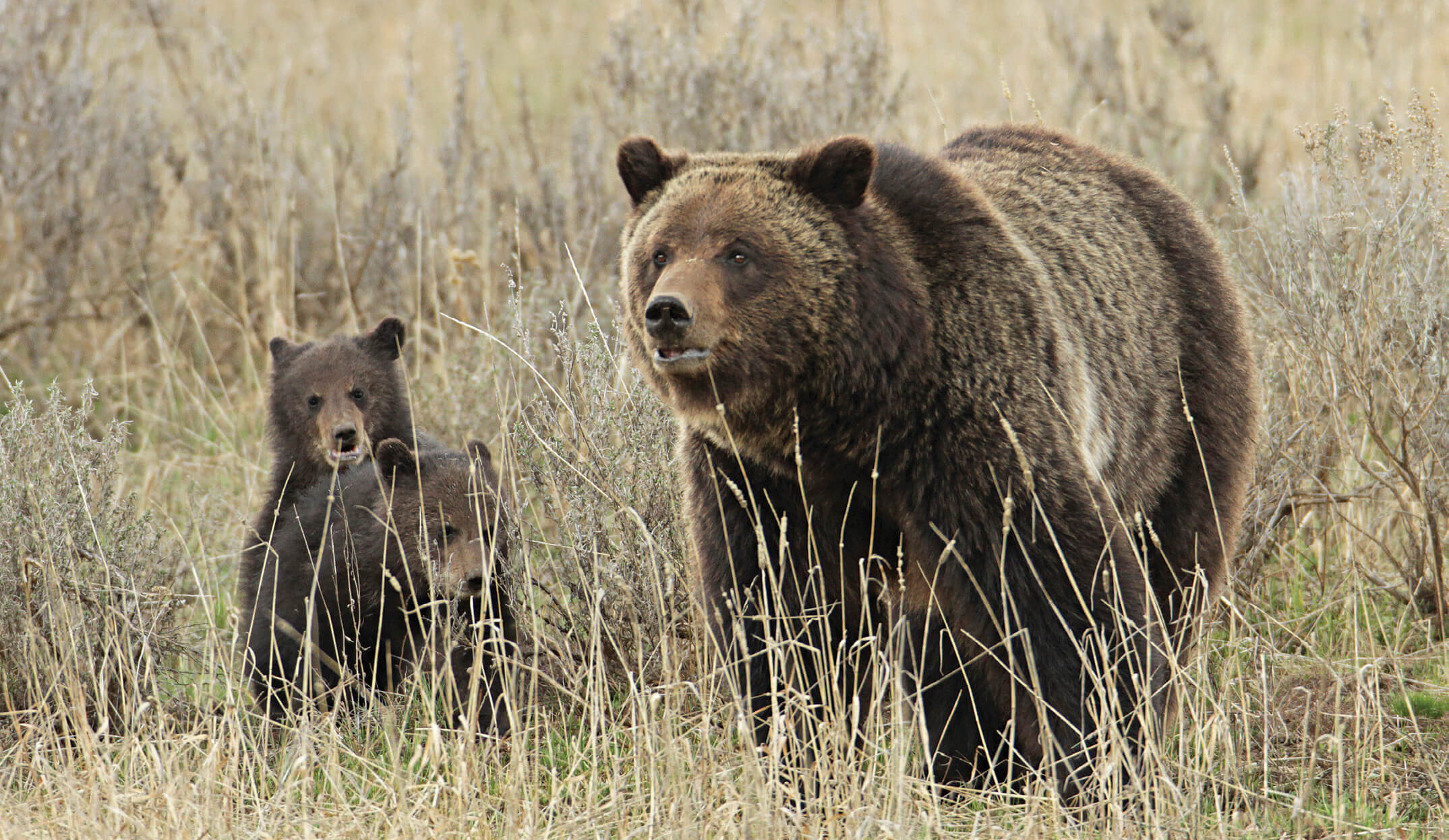
01 Jun At Bear Minimum
I’m watching claws and jaws. Snowflakes and fur are swirling through the scene, too, perfectly focused in my camera’s lens. The claws and jaws belong to a female grizzly bear. It’s snowing in late May. Two small puffs of fur, the sow’s twins, weave between their mother’s legs, roll in the snow, and climb on her back, transferring white crystals from their coats to hers. The cubs never stop moving. Mama bear never stops digging: She’s grubbing food for three hungry mouths that recently emerged from winter hibernation.
I’m a safe distance from the bears. They’re within view from the road, so I’ve stopped to watch, bear spray on my hip and camera in hand. I’m following grizzlies through the Greater Yellowstone Ecosystem (GYE), which includes Yellowstone and Grand Teton national parks, plus portions of Idaho, Montana, and Wyoming. This grizzly footage I’m collecting on the side of the road will turn out to be the best I’ve captured, but as I pull my tripod out of my truck, it feels like the worst moment of the summer: I spot the crust of a peanut butter and jelly sandwich at my feet in that narrow strip of rumpled gravel, barely a foot wide, where the asphalt ends and mud begins. Whether randomly thrown out of a passing car window or purposely put there, I don’t know, but it has to go. Twigs and stones come with the crust as I shove the potential bear bait into an empty bag in my lunchbox.
The discarded sandwich wasn’t mine when I arrived, but I’m making sure it’s not the bear’s when I leave. A century ago we fed bears, but that’s illegal in many places today. It’s one of the wrongs we’ve had to make right for the sake of saving the wild. We’ve figured out all kinds of ways to help the GYE’s grizzly population recover from less than 200 in the 1980s to more than 1,000 today. Keeping our garbage out of their space is just the beginning.
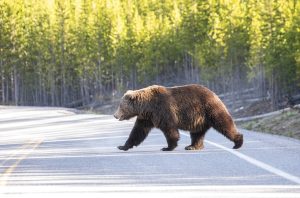
Bears pack on as much fat as possible ahead of hibernation, traveling throughout the Greater Yellowstone Ecosystem in search of something to eat. Many bears easily cover more than 1,000 miles in one summer. Photographed by NPS PHOTO/JIM PEACO
Yellowstone National Park
It took Yellowstone National Park decades to talk tourists out of feeding bears. That’s because feeding the bears was the park’s main attraction in the early 1900s. If one bear wasn’t at your car window, one dozen were at the dump. The park established open trash pits surrounded by bleachers, and watching grizzly and black bears rummage through the garbage became a spectator’s event. “Early in the evening, maybe some black bears would be on the open dumps,” says Alicia Murphy, a historian for the National Park Service in Yellowstone. “After that, grizzly sows with cubs would come and push the black bears off. And then, last but not least, big boars would come in and kind of rule the roost for the rest of the evening.”
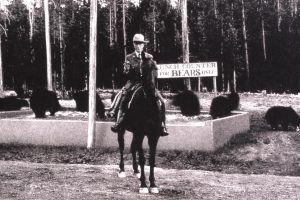
Yellowstone National Park offered bears garbage meals in the early 1900s. Tourists were invited to fill the stands around the dumps — this one was known as the Lunch Counter. Photographed by YELLOWSTONE NATIONAL PARK ARCHIVES
Park officials eventually realized there was a problem with the circus-like concept. Grizzlies had become dependent on handouts, and people were on the deadly end of that exchange. Often, bears became aggressive in their quest to obtain food. So, in 1970, park officials began removing open-pit garbage dumps. The grizzly population plummeted. People panicked, believing the bears were starving without access to human foods — and those that had become dependent on trash actually were. This contributed to an already struggling population of grizzlies that had been declining due to human-caused mortalities and habitat loss. In 1975, after the species had dwindled to the point of occupying only about 2 percent of its former range south of Canada, grizzly bears landed on the endangered species list.
The few hundred bears that hung on went back to being wild as the park transitioned to bear-resistant dumpsters and secure food storage bins in campgrounds. Today, front-country camps have to be clean, and backcountry campers have to hang their food out of a bear’s reach.
Grand Teton National Park
Grizzly sightings in the GYE were extremely rare in the 1980s and ’90s, but the population slowly recovered. By the mid 2000s, we knew we’d changed our ways for the better. Grizzly No. 399 — named for her research number with the Interagency Grizzly Bear Study Team — became well known in Grand Teton National Park in the early 2000s for her tendency to spend summer months near roadsides in the park. Photographers and tourists became her paparazzi.
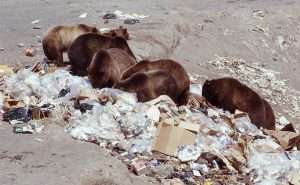
Yellowstone National Park stopped giving garbage to grizzlies in the 1970s, and bears had to learn how to be wild again by foraging for their own food. As a result, conflicts with people decreased. Photographed by YELLOWSTONE NATIONAL PARK ARCHIVES
Traffic jams — also called bear jams — became commonplace with 399 living so close to the roads. So, in 2007, park officials started the Wildlife Brigade, a group of three dozen staff and volunteers who keep the chaos in check when bears alongside the road draw the attention of park visitors. “At a bear jam, it can be really stressful,” says Grand Teton National Park bear biologist Justin Schwabedissen. “Be patient with the staff. We really want people to see bears here in Grand Teton. We just want to make sure that it’s done safely for both bears and people.”
The Wildlife Brigade started counting bear jams in 2014. Since then, as the number of park visitors has increased, the number of traffic jams caused by grizzlies in Grand Teton has nearly doubled from 122 in 2014 to 210 in 2022. It’s unrealistic to expect people to stay completely out of bear country, so the brigade keeps conflicts to a minimum by keeping the crowd and the critters away from each other.
Idaho
The bear dynamic outside of the two national parks is much more challenging. Many people visit the parks hoping to spot a grizzly. Meanwhile, people living in the states surrounding the parks often have to adopt new habits to live among bears safely.
Rich Paini, co-owner of TroutHunter fly-fishing lodge in Island Park, Idaho, is one such person. In September 2011, he was attacked by a grizzly while bow hunting for elk in tall willows. Both he and the bear survived, but Paini lost his left ring finger, and he doesn’t hunt in low-visibility areas anymore.
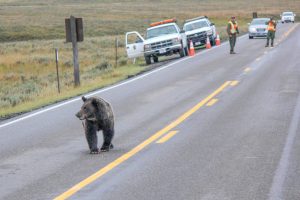
Traffic jams happen quickly when grizzlies are near roads. Grand Teton National Park has a team of staff and volunteers — the Wildlife Brigade — that manages jams and maintains distance between people and wildlife. Photographed by NPS PHOTO/ERIC JOHNSTON
“There will certainly be conflicts,” Paini says. “But who’s fault is that?” Paini says that the way people operate in bear country has to change because the success of an expanding grizzly population requires it. Bear-resistant trash receptacles are showing up in his area, people are carrying bear spray, and, just down the hill from him in Ashton, Idaho, fruit is disappearing.
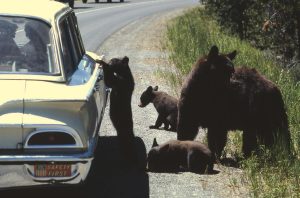
A century ago, tourists visited Yellowstone National Park specifically for the opportunity to feed black bears and grizzlies. It took the park several decades to break visitors of the habit. Feeding bears is no longer allowed. Photographed by YELLOWSTONE NATIONAL PARK ARCHIVES
Ashton is a small agricultural town neighboring Yellowstone and Grand Teton. Grain silos and potato fields signify the area’s farming legacy, but what grows in people’s backyards is a priority for bears: oftentimes, it’s apples. In the fall, as bears prepare for hibernation, grizzlies are drawn into town to eat apples off branches and those left rotting on lawns, so Idaho Fish and Game has begun taking away the treats. Wildlife managers work with residents to collect unwanted fruit, leaving Ashton annually with 2,000 pounds of apples.
Montana
Apples picked by Idaho Fish and Game go to bears at the Grizzly & Wolf Discovery Center in West Yellowstone, Montana. Many of the grizzlies at the center are there because they liked our food better than their own. Though they’ve been pulled from the wild, they are helping the wild: Captive bears break up their caged existence by breaking into containers, testing prototypes of bear-resistant trash cans and containers. In the 1990s, only 10 percent of the products tested were resistant to a bear’s efforts; now, 45 percent are certified bear-resistant.
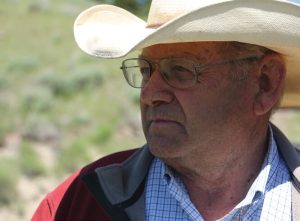
John Crumley, president of the Madison Valley Ranchlands Group, grazes cattle in bear country. He’s lost a few cows to grizzlies in recent years. In 2022, Montana’s Livestock Loss Board paid ranchers nearly $130,000 for livestock killed by grizzlies. Photographed by TIGHT LINE MEDIA
“There is that saying that a fed bear is a dead bear, and it really is true,” says Randy Gravatt, the center’s container testing coordinator. What he’s referring to is the fact that a bear that becomes used to eating human foods may become aggressive toward people, and when this happens, wildlife managers are often required to euthanize the dangerous bear. “We want to make sure that the product passes the test to help those bears out in the wild so that they don’t get in trouble.”
Coolers aren’t a bear’s only temptation. Cattle are enticing, too. An expanding population of predators is tough to work with when your livelihood is at risk, and the situation is complicated because bears and other wildlife are managed as public resources. A Montana Department of Livestock program reimburses producers the market value of dead livestock that have been killed by carnivores. In 2022, the board paid ranchers nearly $130,000 for animals killed by grizzlies. “We have to be here because we have cows here, and we have a living here,” says John Crumley, Madison Valley Ranchlands Group president. “You carry a gun. You carry bear spray. Yeah, it’s changed.”
Crumley’s group has also developed a new compost pile to reduce the number of bears attracted to area ranches. Instead of leaving dead cattle on the ranch to decompose, where grizzlies could come in and scavenge, the carcasses are collected and taken to a secure site where they are turned into compost.
Wyoming
A century ago, we fed grizzlies our garbage. Now, we don’t, or at least not purposely, and Kristin Combs is making sure of it. She’s the executive director of Wyoming Wildlife Advocates, an organization based in Teton County, Wyoming, where a new bear-resistant bin ordinance is in effect. All trash cans must be converted to the kind that claws can’t open. Combs says the conversion is long overdue, and her organization is working to help residents with the change by offering bear-resistant trash cans. “Just knowing that there’s this opportunity for bears to have conflicts with people and that we haven’t done anything as a community to prevent that, it’s shocking and disappointing,” Combs says. “It’s going to take a community-wide effort here to get so we can live alongside grizzlies.”
The drive is just minutes between Combs’ assembled cans stored at the National Elk Refuge near Jackson Hole, Wyoming and those grubbing grizzlies that I filmed.
I check on the three bears as I travel home to Idaho. The shin-tall cubs are still overloaded with curiosity and cabin fever. They climb trees like my boys do. They wrestle with each other like my boys do, too. I could watch them all day, but I don’t have all day; last light is creeping close. The sow moves off a bright white heap of winter leftovers, then strides into the dark. Her twins follow, the emerald cover of needled evergreens dropping a curtain on their playtime. I can’t see them anymore, and, much to my relief, I can’t see any more human food either. The shoulder of the road is void of sandwich scraps. That’s one more day of grizzlies going without our garbage. History, at least in this, is not repeating.




No Comments